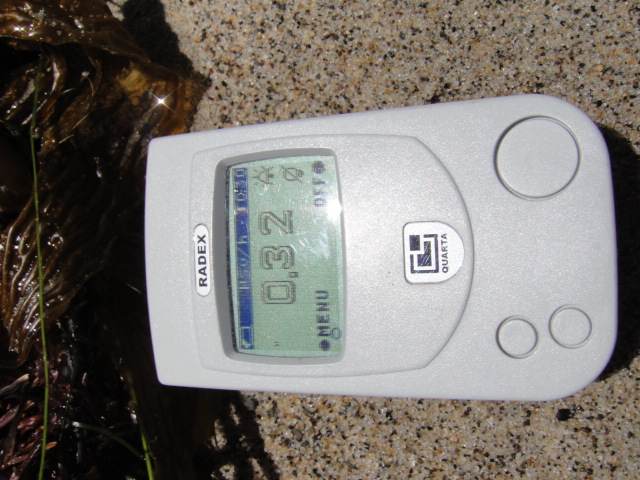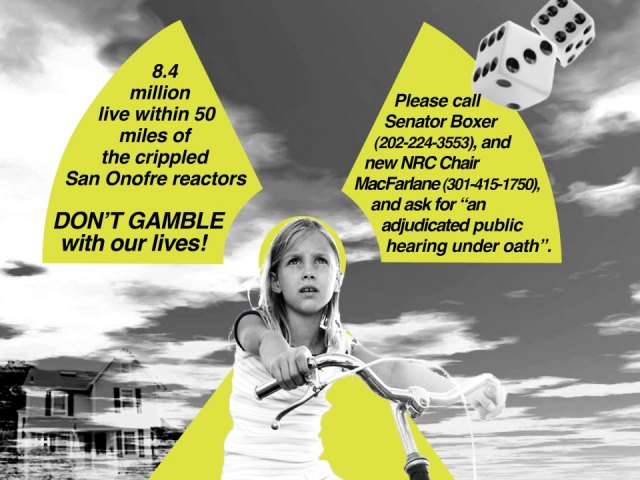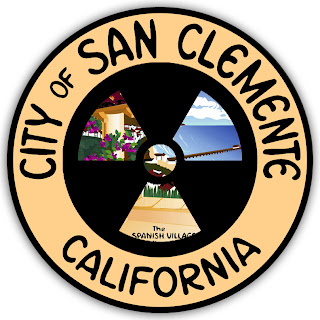via Kyodo News / May 21, 2013 / The United Nations is considering excluding measures to prevent a nuclear accident caused by earthquake and tsunami from a new framework on disaster risk reduction expected to be adopted at the next world conference in 2015, U.N. sources said Tuesday. A Japanese government official involved in drafting the new framework, which will be discussed at the U.N.-sponsored World Conference on Disaster Reduction … Continue reading →
Continue readingCategory Archives: Energy
via Tokyo AP / May 23, 2013 / Keeping the meltdown-stricken Fukushima nuclear plant in northeastern Japan in stable condition requires a cast of thousands. Increasingly the plant’s operator is struggling to find enough workers, a trend that many expect to worsen and hamper progress in the decades-long effort to safely decommission it. Tokyo Electric Power Co., the utility that runs the Fukushima Dai-ichi plant that melted down in March … Continue reading →
Continue readingvia NewsOnJapan.com / May 23, 2013 / The Nuclear Regulation Authority accepted on Wednesday an assessment that a reactor at the Tsuruga plant in western Japan is sitting above an active fault, making it increasingly difficult for the facility to resume operation. It is the first time Japan’s regulatory authorities have acknowledged an existing reactor is located above a fault feared to move in the future, according to an NRA … Continue reading →
Continue readingvia The Star / May 22, 2013 / Farmers have resumed planting rice for market only 15 kilometres (nine miles) from Japan’s crippled Fukushima Daiichi nuclear power station, a local official said Wednesday. It was the first time since the March 2011 earthquake-tsunami-nuclear disaster that farmers have gone inside the former 20-kilometre “no-go” zone around the doomed plant to sow rice intended for sale. The zone has been redefined to … Continue reading →
Continue reading The Radiation Bulletin is published by the Abalone Alliance Clearinghouse.
The Radiation Bulletin is published by the Abalone Alliance Clearinghouse.
The Nuclear Fuel Cycle is the Achilles heal of the nuclear industry. From uranium mining to the deadly spent fuel of reactors, here’s the news that never makes the national news for a reason. This edition of the Radiation Bulletin includes a lot of Department of Energy news.
Continue reading The Radiation Bulletin is published by the Abalone Alliance Clearinghouse.
The Radiation Bulletin is published by the Abalone Alliance Clearinghouse.
The US main stream media fails to cover the Fukushima disaster as a favor to the nuclear industry. This edition of the Radiation Bulletin is a day by day listing by title of all the news on Fukushima coming from the english press in Japan.
Continue readingACTION ALERT:
In light of yesterday’s Atomic Safety and Licensing Board action on behalf of the NRC it is important to remember that the five NRC commissioners can reverse that decision, and they have a record of doing so.
I believe it is time to s…
Continue readingvia Japan Times / May 12, 2013 / Police and the Japan Coast Guard conducted a joint drill Saturday to prepare for a possible terrorist attack on the Fukushima No. 1 nuclear power plant. About 150 officers and other people, including members of a special assault team of the police, participated in the drill at the Fukushima No. 2 nuclear power plant, about 10 km from Fukushima No. 1. Both … Continue reading →
Continue readingby Bryan Walsh / via Time / May 1, 2013 / Honestly, if the consequences weren’t potentially so dire, the ongoing struggles to clean up the Fukushima Daiichi nuclear plant in northern Japan would be the stuff of comedy. In March, an extended blackout disabled power to a vital cooling system for days. The cause: a rat that had apparently been chewing on cables in a switchboard. As if that’s … Continue reading →
Continue readingvia World Nuclear News / May 14, 2013 / A four-year process is planned to rebuild the cover over Fukushima Daiichi 1, equipping it to remove used reactor fuel still stored there. Tokyo Electric Power Company (Tepco) will take away the roof of the temporary cover structure that was put in place to reduce radioactive emissions to air in the six months after the accident in 2011. This will give … Continue reading →
Continue readingvia Wall Street Journal / by Yuko Takeo / May 13, 2013 / A new study offers fresh insights into how radioactive contamination from the Fukushima nuclear disaster may have spread through Japan’s interconnected waterways, reaching some freshwater fish hundreds of kilometers away. The research by two Japanese academics published in “Nature” magazine late last month reports traces of cesium found in 2011 “even in Shizuoka prefecture, 400 km south-west from the … Continue reading →
Continue readingToshiaki Mizuno1 Hideya Kubo1 Affiliations Contributions Corresponding author Scientific Reports 3, Article number: 1742 doi:10.1038/srep01742 Received 13 March 2012 Accepted 05 April 2013 Published 29 April 2013 Article tools PDF Download as PDF (536 KB) View interactive PDF in ReadCube Citation Reprints Rights & permissions Metrics This paper focuses on an overview of radioactive cesium 137 (quasi-Cs137 included Cs134) contamination of freshwater fish in Fukushima and eastern Japan based … Continue reading →
Continue reading The Radiation Bulletin is published by the Abalone Alliance Clearinghouse.
The Radiation Bulletin is published by the Abalone Alliance Clearinghouse.
The Nuclear Fuel Cycle is the Achilles heal of the nuclear industry. From uranium mining to the deadly spent fuel of reactors, here’s the news that never makes the national news for a reason. This edition of the Radiation Bulletin includes a lot of Department of Energy news.
Continue reading The Radiation Bulletin is published by the Abalone Alliance Clearinghouse.
The Radiation Bulletin is published by the Abalone Alliance Clearinghouse.
The US main stream media fails to cover the Fukushima disaster as a favor to the nuclear industry. This edition of the Radiation Bulletin is a day by day listing by title of all the news on Fukushima coming from the english press in Japan.
Continue reading The Radiation Bulletin is published by the Abalone Alliance Clearinghouse.
The Radiation Bulletin is published by the Abalone Alliance Clearinghouse.
The Nuclear Fuel Cycle is the Achilles heal of the nuclear industry. From uranium mining to the deadly spent fuel of reactors, here’s the news that never makes the national news for a reason. This edition of the Radiation Bulletin includes a lot of Department of Energy news.
Continue reading The Radiation Bulletin is published by the Abalone Alliance Clearinghouse.
The Radiation Bulletin is published by the Abalone Alliance Clearinghouse.
The US main stream media fails to cover the Fukushima disaster as a favor to the nuclear industry. This edition of the Radiation Bulletin is a day by day listing by title of all the news on Fukushima coming from the english press in Japan.
Continue readingCalifornia Congressman Henry Waxman responds to questions from Myla Reson and Roger Johnson about the Nuclear Regulatory Commission’s (NRC) handling of Southern California Edison’s push to fasttrack the restart of one of San Onofre’s faulty reactors…
Continue readingBags, Tape, Broomsticks, San Onofre & Repair, words you don’t want to hear in the same sentence.
From Tonights 5pm @10News.
Fukushima USA
Aging Nuke Plants On Fault Lines In Tsunami Hazard Zones = Fukushimas… Any Questions?
PLEAS…
 The Radiation Bulletin is published by the Abalone Alliance Clearinghouse.
The Radiation Bulletin is published by the Abalone Alliance Clearinghouse.
The Nuclear Fuel Cycle is the Achilles heal of the nuclear industry. From uranium mining to the deadly spent fuel of reactors, here’s the news that never makes the national news for a reason. This edition of the Radiation Bulletin includes a lot of Department of Energy news.
Continue reading The Radiation Bulletin is published by the Abalone Alliance Clearinghouse.
The Radiation Bulletin is published by the Abalone Alliance Clearinghouse.
The US main stream media fails to cover the Fukushima disaster as a favor to the nuclear industry. This edition of the Radiation Bulletin is a day by day listing by title of all the news on Fukushima coming from the english press in Japan.
Continue reading

A seaweed clump lying directly in front of San Onofre Nuke has a high reading.
By Yoichi Shimatsu
|
PLEASE Turn off a light for Fukushima USA / San Onofre
For the first time, a source from inside the San Onofre nuclear power plant has come forward to warn that restarting the power plant is too dangerous.
“There is something grossly wrong,” said the inside source, a safety engineer who worked at San On…
Continue readingJoin us & the San Clemente Times for Beachside Chat Friday, April 19 at 8 a.m. at Café Calypso, at 114 Avenida Del Mar.
The guests for Beachside Chat Friday will include members of San Clemente’s Community Emergency Response Team, as well as city emergency planning officer Jen Tucker. They will discuss the CERT program and emergency response plans for the city.
Beachside Chat is held the first and third Fridays of each month at Café Calypso.
 |
| Don’t Let San Clemente California Become Fukushima USA |
PLEASE Turn off a light for Fukushima USA / San Onofre
 The Radiation Bulletin is published by the Abalone Alliance Clearinghouse.
The Radiation Bulletin is published by the Abalone Alliance Clearinghouse.
The Nuclear Fuel Cycle is the Achilles heal of the nuclear industry. From uranium mining to the deadly spent fuel of reactors, here’s the news that never makes the national news for a reason. This edition of the Radiation Bulletin includes a lot of Department of Energy news.
Continue reading The Radiation Bulletin is published by the Abalone Alliance Clearinghouse.
The Radiation Bulletin is published by the Abalone Alliance Clearinghouse.
The US main stream media fails to cover the Fukushima disaster as a favor to the nuclear industry. This edition of the Radiation Bulletin is a day by day listing by title of all the news on Fukushima coming from the english press in Japan.
Continue readingvia ex-SKF / April 19, 2013 / Meanwhile in one of the most contaminated towns and villages in Fukushima after the nuclear accident more than two years ago, officials have just launched a new program to encourage children to receive annual health checkups. If a child undergoes one annual health checkup, he/she will receive 10,000 yen (these days it’s close to US$100) worth of book coupons (gift certificates for books). … Continue reading →
Continue readingby Yuri Kageyama / Japan Times / April 18, 2013 / Despite high stakes, lawsuit getting scant media attention Their demand: The right to live free of radiation. The plaintiffs who started the legal battle: 14 children. The Sendai High Court is expected to rule soon on this unusual lawsuit, which was filed on behalf of the children by their parents and antinuclear activists in June 2011 in the district … Continue reading →
Continue readingvia NPR / by Steve Inskeep and Geoff Brumfiel / April 17, 2013 / A team from the International Atomic Energy Agency is in Japan visiting the Fukushima Daiichi nuclear power plant. The visit comes a week after reports emerged that large amounts of radio…
Continue readingvia The Asahi Shimbun / April 20, 2013 / Fourteen workers treated radioactive water leaking at the crippled Fukushima No. 1 nuclear plant without wearing personal dosimeters as required, Tokyo Electric Power Co. said April 19. The dosimeters, which are…
Continue readingvia The Asahi Shimbun / April 20, 2013 / Fourteen workers treated radioactive water leaking at the crippled Fukushima No. 1 nuclear plant without wearing personal dosimeters as required, Tokyo Electric Power Co. said April 19. The dosimeters, which are worn on a worker’s finger, measure and record the doses of beta rays, or high-speed electrons. According to TEPCO, the 14 workers are employees of a partner company that engaged … Continue reading →
Continue readingCitizen Power
Just give me the warm power of the sun
Give me the steady flow of a waterfall
Give me the spirit of living things as they return to clay.
Just give me the restless power of the wind
Give me the comforting glow of a wood fire
But ple…
Miki Day, concerned Japanese mother living in California, tells of the contaminated food in Japan and the sad situation for children in Fukushima. She speaks out against the dangerous plan to restart California’s San Onofre nuclear reactor without f…
Continue readingUrban Planner and father of three talks about the devastating effect a nuclear accident at the leaky San Onofre nukes would have on the ‘built environment,’ the real estate, industry, agriculture and infrastructure of Southern California.
Do you…
Continue readingGary & Lauri Headrick, founders of SanClementeGreen.org tell why they are devoting their lives to seeing that the crippled San Onofre nuclear power plant is shutdown for good.
Aging Nuke Plants On Fault Lines In Tsunami Hazard Zones = Fu…
Continue readingInvestigative Journalist Harvey Wasserman, long-time anti-nuclear activist, editor of http://www.nukefree.org/ lays out the risks of a San Onofre restart. Read his report on recent developments in San Onofre to the Public: DROP DEAD! http://ww…
Continue reading The Radiation Bulletin is published by the Abalone Alliance Clearinghouse.
The Radiation Bulletin is published by the Abalone Alliance Clearinghouse.
The Nuclear Fuel Cycle is the Achilles heal of the nuclear industry. From uranium mining to the deadly spent fuel of reactors, here’s the news that never makes the national news for a reason. This edition of the Radiation Bulletin includes a lot of Department of Energy news.
Continue reading The Radiation Bulletin is published by the Abalone Alliance Clearinghouse.
The Radiation Bulletin is published by the Abalone Alliance Clearinghouse.
The US main stream media fails to cover the Fukushima disaster as a favor to the nuclear industry. This edition of the Radiation Bulletin is a day by day listing by title of all the news on Fukushima coming from the english press in Japan.
Continue readingEmergency response professional Deanna Polk talks about the many holes in radiological emergency preparedness in the region surrounding the leaky San Onofre nuke, including lack of training and resources for first responders and the absence of a rea…
Continue readingvia ex-SKF / April 12, 2013 / Jiji Tsushin (4/13/2013) says TEPCO has reported to the Nuclear Regulatory Authority that the in-the-ground water storage pond No.1 is indeed leaking into the surrounding soil. TEPCO’s handout for the press on April 13, 2013 shows that beta nuclides are being detected in the water taken from either the drains or the leak detection pipes or both in not only the ponds Nos … Continue reading →
Continue readingSan Clemente resident Donna Gilmore, the founder of SanOnofreSafety.org talks about her own process of awakening to the risks posed by the nearby San Onofre nuclear reactors, and her discovery, confirmed by the Governor’s Office that Gov. Brown has …
Continue readingS. David Freeman, legendary former Tennessee Valley Authority and the Sacramento Municipal Utility District administrator, who has shutdown many a nuke in his career – and is now working in his 85th year to help local residents and Friends of the E…
Continue readingis now clear that the NUCLEAR MAFIA
and their cronies at the NRC, U.S. Gov’t
and CA State Gov’t plan to perpetrate another act of nuclear terrorism upon
the people of Southern California and the world. By allowing Southern
California Edison to restart the damaged and defective reactor number two that
has not even been repaired, to experimentally restart at 70% power sometime in
June or July 2013.
say terrorism because many people in California are afraid for the health of
their children, their property values, and what would happen if a major nuclear
accident happened at San Onofre Nuclear Generating Station? By definition
terrorism is an act that its purpose is to create fear. Just thinking about the
evacuation plan that every Californian knows would not work, and having to
shelter in place during a nuclear meltdown at SONGS. Then after the radiation damage to people’s
health has been done just like Chernobyl and Fukushima, the government will
announce in a month or two (far too late) that in a 10, 20 or 30 mile radius
will be an exclusion zone due to high radiation levels, and everyone has to
leave their homes and possessions to go live in a refugee camp somewhere in
Riverside County. The loss of billions in property values, infrastructure
(schools, roads, beaches, farm land and food crops, local governments) personal
disruptions and destruction of several millions lives, all put at risk in the
name of profits for SCE.
 What
Whatwill be the fate of Southern California if this act of Nuclear Terrorism by the NUCLEAR MAFIA is allowed this experimental
restart at San Onofre Nuke plant?
PLEASE Turn off a light for Fukushima USA / San Onofre
via ex-SKF / April 11, 2013 / And the latest from TEPCO on April 11, 2013 in the email notice to the press No.35: ?????No.3??No.6???????????11?????????????????????????…
Continue reading
PLEASE Turn off a light for Fukushima USA / San Onofre
 The Radiation Bulletin is published by the Abalone Alliance Clearinghouse.
The Radiation Bulletin is published by the Abalone Alliance Clearinghouse.
The Nuclear Fuel Cycle is the Achilles heal of the nuclear industry. From uranium mining to the deadly spent fuel of reactors, here’s the news that never makes the national news for a reason. This edition of the Radiation Bulletin includes a lot of Department of Energy news.
Continue reading The Radiation Bulletin is published by the Abalone Alliance Clearinghouse.
The Radiation Bulletin is published by the Abalone Alliance Clearinghouse.
The US main stream media fails to cover the Fukushima disaster as a favor to the nuclear industry. This edition of the Radiation Bulletin is a day by day listing by title of all the news on Fukushima coming from the english press in Japan.
Continue readingvia Washington’s Blog / April 6, 2013 / Is Fukushima Leaking … Or Are the the Reactors Wholly Uncontained? You may have heard that TEPCO – the operator of the stricken Fukushima nuclear power plants – announced a large leak of radioactive w…
Continue readingTo my friends,
Residents Organized for a Safe Environment (ROSE) is proud and happy to announce our first solar project in conjunction with the Boy Scouts of America, Orange County. For practical and teaching purposes, ROSE will …
Continue reading
NRC: The Good, The Bad and the Ugly
At San Onofre by Region IV and the NRC: The papers shown below have been obtained from Public Domain written by Dr. Joram Hopenfeld and a former SONGS Employee based on his investigation of the steam generator issues, review of the plant data and discussions with several Key SONGS Insiders. These papers confirm that Southern California Edison wants to restart unsafe Unit 2 nuclear reactor at 70% power under false pretenses, just for profits, and as an unapproved risky experiment by subverting the NRC and Federal regulatory process. The true Root Cause (See Note 2) of the unprecedented tube-to-tube wear in Unit 3 has NOT been officially established, as required by NRC Confirmatory Letter Action 1 for restarting the defectively designed and degraded Unit 2. NRC has not even completed their review of Unit 2 Return to Service Reports, nor have they finished Special Unit 2 Tube Inspections, nor have they (publicly?) reviewed SCE’s Response to NRC’s Requests for Additional Information (RAIs).
NOTE: NO FINES ARE MENTIONED – WHY?
Now, SCE wants the NRC to approve a new shady License Amendment, undermining public safety and they want it done without the involvement of Public Safety Experts, Attorneys and/or Citizens/Ratepayers. After the review of the Mitsubishi Root Cause Evaluation and the Draft SCE License Amendment, it is crystal clear that the NRC needs to follow the example of their own enforcement at David Besse together with the lessons learned from Fukushima, when it comes to NOT approving this new Shady License Amendment for restarting San Onofre Unit 2’s defectively designed and degraded replacement steam generators. In light of the unanticipated/unprecedented tube leakage at San Onofre Unit 3, the health and safety, along with the economic concerns/objections of 8.4 million Southern Californians’ MUST OVERRIDE and PREVENT the restarting of Unit 2 at ANY power level. In a Democratic Society, truth must prevail over profit motivations, misleading propaganda of electricity service disruption and/or projected probabilistic temporary inconveniences to the public based on phony data, because America cannot afford a trillion dollar nuclear eco-disaster!
=======================================================================
Additional Information:
Part 2 https://docs.google.com/folder/d/0BweZ3c0aFXcFZGpvRlo4aXJCT2s/edit?
pli=1&docId=1wkyTGWUy0pIXjBXc91JWr6_ACB3d-AIQbuVVZtDRZvI
PLEASE Turn off a light for Fukushima USA / San Onofre
by John Hofilena / via Japan Daily Press / April 1, 2013 / Tokyo Electric Power Co. (TEPCO) has come out and publicly said on Friday that it deserves a majority of the blame for the Fukushima nuclear disaster, a very strong statement about the company?…
Continue reading



